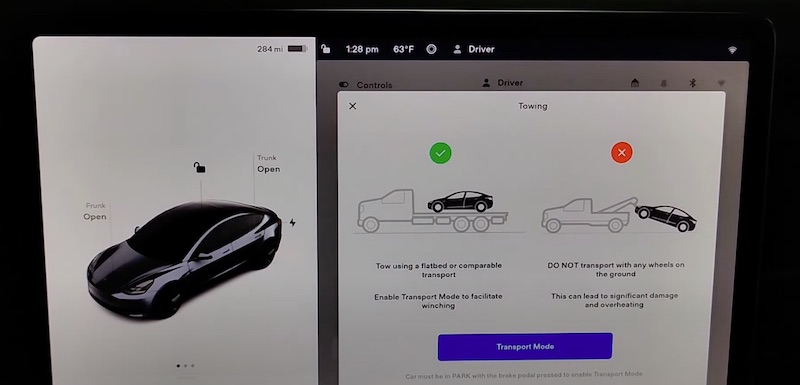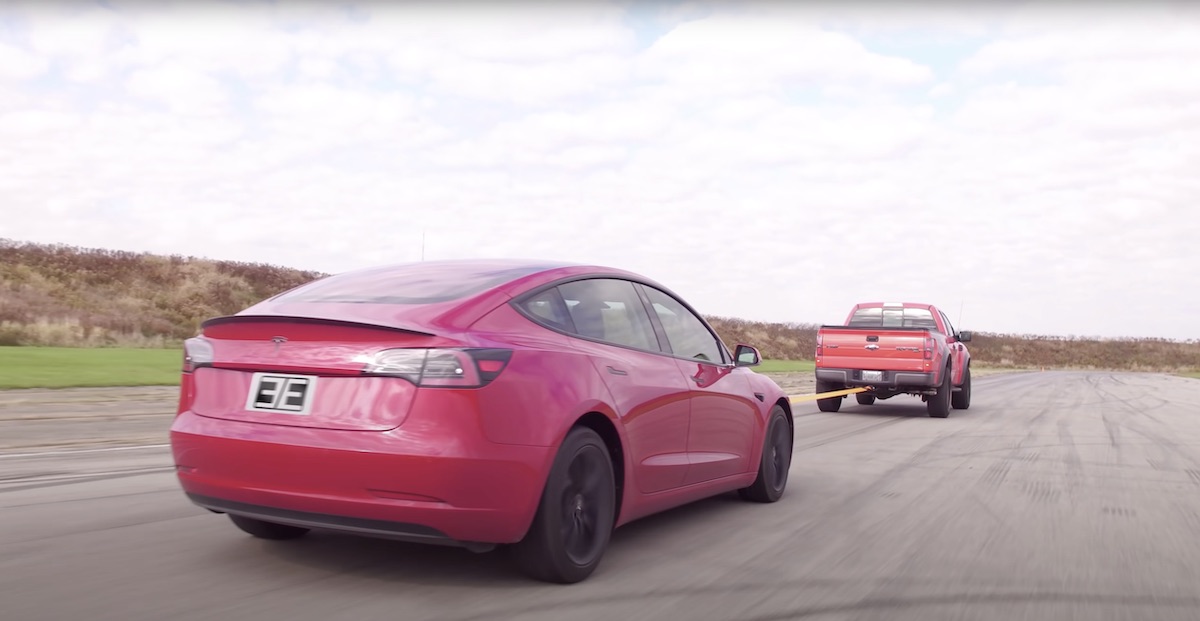If you’re a Tesla owner, you may be wondering if your electric vehicle can be towed.
The answer is yes, but there are some important things to keep in mind.
In this guide, we’ll cover the basics of Tesla towing, including which Tesla models can be towed, how to prepare your Tesla for towing, methods of towing, potential risks and damages, and other important considerations.
Contents
Understanding Tesla Towing
In this section, we’ll discuss the basics of Tesla towing, and specifics on the different models.
Tesla Towing Basics
When it comes to towing a Tesla, there are a few things you need to know.
First and foremost, Tesla strictly forbids flat towing any of their vehicles, including the Model S, Model X, Model 3, and Model Y. Flat towing is when a vehicle is towed with all wheels on the ground, typically behind an RV.
However, most electric cars, including Teslas, cannot be flat towed because the drive train cannot be pulled at high speeds for long periods.
The only approved method of towing a Tesla involves transporting it with all four wheels off the ground using a flatbed tow truck or wheel lifts and dollies. Because the wheels generate power when they spin, towing with the wheels in contact with the ground can result in overheating and significant damage.
It’s also important to note that towing a Tesla can have an impact on the vehicle’s range. When towing a heavy load, the Tesla’s battery will drain faster, reducing the overall range of the vehicle.
Tesla Models and Towing
Not all Tesla models are created equal when it comes to towing.
Here’s a breakdown of which models can be towed and how much weight they can handle:
- Model S: The Model S can be towed, but only with the optional tow hitch accessory. With the tow hitch, the Model S can tow up to 2,000 pounds.
- Model X: The Model X comes standard with a tow hitch and can tow up to 5,000 pounds.
- Model 3: The Model 3 can be towed, but only with the optional tow hitch accessory. With the tow hitch, the Model 3 can tow up to 2,000 pounds.
- Model Y: The Model Y comes standard with a tow hitch and can tow up to 3,500 pounds.
It’s important to note that towing capacity can vary depending on the specific model and configuration of your Tesla. Always consult your owner’s manual or Tesla’s website for the most up-to-date information on towing capacity.
Preparing Your Tesla for Towing
If you need to tow your Tesla, it is important to prepare it properly to ensure that it is done safely and without damaging the vehicle.
Here are some steps to follow when preparing your Tesla for towing.
Activating Transport Mode
Before you can tow your Tesla, you need to activate Transport Mode. This mode disables certain features of the car to make it safer to tow, such as the automatic parking brake and the power steering.
Here’s how to activate Transport Mode:
- Go to the dashboard controls and select “Settings”.
- Click on “Vehicle” and then “Transport”.
- Enable Transport Mode.

Note that Transport Mode may require a software update, so make sure your Tesla is up to date before attempting to activate it.
Safety Precautions
Towing a Tesla requires some safety precautions to prevent damage to the vehicle.
Here are some things to keep in mind:
- Always use a flatbed tow truck or a tow dolly with the drive wheels off the ground. Never tow a Tesla with the drive wheels on the ground, as this can damage the electric motor.
- If you must use a tow dolly, make sure to apply an external steering yoke or steering wheel lock to prevent the front wheels from spinning.
- Charge the battery before towing to ensure that all necessary systems can operate during the towing process.
- If you’re towing your Tesla behind an RV, make sure to follow the RV manufacturer’s guidelines for towing.
By following these steps and safety precautions, you can ensure that your Tesla is properly prepared for towing and avoid any potential damage to the vehicle.
Methods of Towing a Tesla
When it comes to towing a Tesla, there are specific methods that you need to follow to ensure that you don’t cause any damage to the vehicle. In this section, we will discuss some of the most common methods of towing a Tesla.
1. Flatbed Truck Towing
One of the safest ways to tow a Tesla is by using a flatbed truck. This method involves placing the entire vehicle on a flatbed trailer and securing it in place with straps.
This method ensures that none of the wheels are in contact with the ground, which prevents any damage to the vehicle’s drivetrain.
2. Using Dollies

This method is ideal for short distances and can be used to move the vehicle around a parking lot or a garage.
3. Flat Towing
Flat towing, also known as dinghy towing, involves towing a vehicle with all four wheels on the ground. This method is not recommended for Tesla vehicles as it can cause significant damage to the drivetrain.
The wheels generate power when they spin, which can lead to overheating and damage to the vehicle’s motor.
4. Wheel Lifts
Wheel lifts are a type of towing equipment that can be used to tow a Tesla. This method involves lifting the front or rear wheels of the vehicle off the ground using a hydraulic lift.
The lifted wheels are then secured in place using straps, and the vehicle is towed with the remaining wheels in contact with the ground.
However, this method is not recommended for long distances as it can cause damage to the vehicle’s drivetrain.
In conclusion, when it comes to towing a Tesla, it’s essential to follow the recommended methods to avoid causing any damage to the vehicle.
Using a flatbed truck or dollies are the safest options, while flat towing and wheel lifts should be avoided.
Potential Risks and Damages
When it comes to towing a Tesla, there are some potential risks and damages that you should be aware of.
In this section, we’ll discuss some of these risks and damages, including battery and overheating issues, as well as damage to components.
1. Battery and Overheating
One of the biggest risks of towing a Tesla is the potential for battery and overheating issues. Since Tesla cars generate energy when they are being towed, overheating can be a real concern.
If the car overheats, it could cause damage to the battery and electrical system. In extreme cases, it could even start a fire, which could cause serious injuries to others.
To avoid these risks, it’s important to follow Tesla’s guidelines for towing. Tesla recommends using a flatbed truck to transport your car, which will prevent the wheels from turning and generating energy.
If you need to use a tow truck, make sure that it is a “bed-tow” truck, which will lift the car off the ground and prevent the wheels from turning.
2. Damage to Components
Another potential risk of towing a Tesla is damage to its components. Towing a car puts a lot of stress on its tires and suspension, which can cause damage if the car is towed improperly.
Additionally, if the car is towed for a long distance, it could cause damage to the battery and electrical system, which could be expensive to repair.
To minimize these risks, it’s important to use a reputable towing company that has experience towing electric vehicles. Make sure that the tow truck driver knows how to properly load and secure your car, and that they follow Tesla’s guidelines for towing. If you’re unsure about the towing process, you can always contact Tesla for advice and guidance.
In summary, towing a Tesla can be risky if you don’t take the proper precautions. Battery and overheating issues, as well as damage to components, are the biggest concerns.
To avoid these risks, make sure that you follow Tesla’s guidelines for towing, use a reputable towing company, and take the necessary steps to protect your car during transport.
Tesla Roadside Assistance and Services
If you’re a Tesla owner, you have access to Tesla’s Roadside Assistance program, which provides immediate support 24/7, 365 days a year. This service is dedicated to helping you with any roadside emergencies you may encounter, such as a flat tire, dead battery, or mechanical breakdown.
Tesla Roadside Assistance
Tesla’s Roadside Assistance program covers towing for up to 50 miles (80 km) to the nearest Tesla Service Center if your vehicle needs repairs.
If you experience a flat tire, Tesla will cover the transportation costs for the first 50 miles (80 km) provided the vehicle is towed to a Tesla Service Center and you complete the tire repair and/or replacement through Tesla directly.
If you’re ever in an unsafe location, contact emergency services first. Then, contact Tesla’s Roadside Assistance team for support. They can assist with basic troubleshooting, provide guidance on how to get your vehicle to a safe location, and arrange for towing if necessary.
Tesla Service and Repairs
Tesla Service Centers provide repairs and maintenance for Tesla vehicles. If your vehicle requires service or repairs, you can schedule an appointment through the Tesla app or by contacting your nearest Tesla Service Center.
Tesla offers a limited warranty for new vehicles, which covers repairs and replacements for certain parts and components. The warranty varies depending on the model and year of the vehicle, so be sure to check your warranty documentation for details.
In addition to the limited warranty, Tesla also offers extended service plans for additional coverage. These plans cover repairs and maintenance beyond the standard warranty period, and can be purchased for up to 8 years or 150,000 miles (240,000 km), whichever comes first.
Overall, Tesla’s Roadside Assistance program and Service Centers provide comprehensive support for Tesla owners in the event of a roadside emergency or vehicle repair.
Other Considerations When Towing a Tesla
When it comes to towing a Tesla, there are a few other considerations that you should keep in mind to ensure that you are doing it safely and correctly.
Here are some important factors to consider:
Towing in Different Directions
If you need to tow your Tesla, it is important to keep in mind that the direction in which you tow it can have an impact on the vehicle’s performance and safety.
For example, if you tow the vehicle backwards, it can cause damage to the motor, transmission, and other components. On the other hand, towing the car forwards can help to preserve its mechanical components.
Weight and Performance
Another important consideration when towing a Tesla is the weight of the vehicle and the performance of the towing vehicle. Teslas are heavy vehicles, and if you are towing them with a vehicle that is not rated for the weight, it can cause damage to both vehicles.
Additionally, the performance of the towing vehicle can impact the safety of the tow. For example, if you are towing a Tesla with a Ford Raptor, which is a high-performance truck, it can cause the Tesla to accelerate too quickly, which can be dangerous.
When towing a Tesla, it is important to take the time to carefully consider all of these factors to ensure that you are doing it safely and correctly.
By taking the time to plan your tow and make sure that you are using the right equipment and following the right procedures, you can help to ensure that your Tesla stays safe and in good condition.

